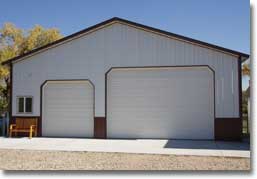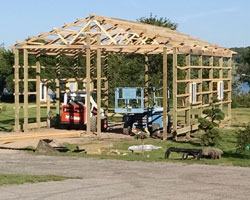Part two of a three part series. See yesterday’s blog for part one.
I’d like to thank Bret Buelo of Wick Buildings for the basis of this article, which appeared on the Wick Buildings website (www.wickbuildings.com) August 12, 2016. Information from Bret’s article appears here in italics along with my comments as well.
Part of the fun of any DIY project is learning new skills to complete a project. However, there is a point where you venture too far into the unknown and begin to cost yourself time, money and perhaps even your own personal safety.
We reached out to Gordon Sebranek, who manages the Engineering Department at Wick Buildings, for some insights.
Pitfalls 4, 5 and 6:
- Can’t See the Big Picture
Construction talent is required when you execute the plans – but what about creating the plans?
Gordon notes that designing a pole barn requires some innate talent as well. “You have to be able to build this in your head,” he explains. That requires envisioning how everything fits together in a building.
Beyond a natural conceptual ability, Gordon said that most designers have advanced schooling in the field, typically a four-year college degree in construction management, or a two year degree in architectural design. And even then, there’s a certain amount of on-the-job experience required to hone that talent.
“We start out entry level designers with simple buildings, and as they get more comfortable, we move on to more complicated jobs,” he said.
Guru comments: We have two things happening here – the design for functionality and the structural design.
For functionality, it takes common sense, and can be helpful to work with an experienced company who does nothing but post frame (pole) buildings.
My recommendation is always to construct the largest building which will fit on your property and within budget. In nearly 20,000 buildings, I have yet to have a client ever come back to me and tell me their building was just too big!
 For buildings which will house vehicles or equipment, it is best to start from the doors. Standard production cars and pickups will fit through nine foot wide by seven foot tall overhead doors – however it is usually best to err on the side of caution and go 10 wide by eight tall. Need two vehicles through the same door (saves on the cost of an opener)? Then increase the width to at least 16 if not 18 feet. Boats, RVs, etc., are usually happiest with 12 foot wide doors and with a 14 foot height, if it can legally go down the highway, without special permits, it will fit through the door.
For buildings which will house vehicles or equipment, it is best to start from the doors. Standard production cars and pickups will fit through nine foot wide by seven foot tall overhead doors – however it is usually best to err on the side of caution and go 10 wide by eight tall. Need two vehicles through the same door (saves on the cost of an opener)? Then increase the width to at least 16 if not 18 feet. Boats, RVs, etc., are usually happiest with 12 foot wide doors and with a 14 foot height, if it can legally go down the highway, without special permits, it will fit through the door.
Place doors three or more feet apart to avoid door dings. Avoid sliding doors unless the building is purely agricultural.
Take the dimensions of stuff you want to place inside the building and allow for enough room to comfortably walk around them.
Add at least two foot in eave height to the tallest door (at a minimum).
For structural design – rely upon a post frame building kit package provider who includes plans sealed by a registered design professional (RDP – architect or engineer) only. Don’t take anything to chance or luck. It isn’t just a ‘pole barn’ it could be the life of you or a loved one!
- Planning Not a Strong Suit
One area that is often overlooked by DIYers is the task of pre-planning. Wick’s approach is much more in-depth than scratching out a shopping list for a lumber yard.
“We give very detailed instructions on how this gets put together,” Gordon said. These construction instructions include line items that specify parts and procedures for construction. They range in size from 20 to 100 pages, and the designer specifies how the project will fit together.
The point is to methodically think through every element of the project beforehand. It’s not that a DIYer can’t do this, it’s just that many don’t have the time, patience or understanding how to create a thorough construction instruction packet.
Guru comments: I agree 100% with having not only plans which spell out what every piece is and where it goes, but also detailed instructions. The Hansen Pole Buildings Construction Manual, as an example, is over 500 pages in length and deals with the specifics of the great majority of how to assemble your new pole building – from dirt to the last screw.
A few pages off a photocopier are not going to provide the in depth tricks of the trade which will save hours of time and give a superior finished product.
- Don’t Have the Experience
Much of what we’ve alluded to already could be lumped under a general heading “experience.” This is a difficult category to write about, because we simply can’t tell you all the tricks of the trade that will help.
Consider Gordon’s explanation about making a pole barn square:
You have to set up your batter boards, run your strings to make sure you’ve got a square box outline to fit your building in. Then you have to make sure all your columns are plumb. But even though you’ve got all of the columns plumb, when you get your trusses set, you have to make sure you’ve got a straight wall at the top and the bottom.
That’s a simple procedure for a builder who’s done it a thousand times. But for the novice, it’s an oversight that could significantly impact your building.
Guru comments: Post frame buildings are great for the average DIYer, as the skills are not ‘rocket science’ for those who can and will read the instructions.
To my Readers… Come back tomorrow for the third installment of the series on DIYers who build their own pole building.







